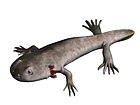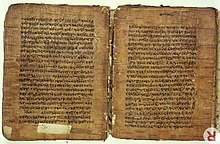스테레오스폰딜로모르파
Stereospondylomorpha| 스테레오스폰딜로모르프스 시간 범위:301–120 엄마 PreꞒ Ꞓ OSDCPTJKPg N. | |
|---|---|
 | |
| Prionosuchus plummeri 삶의 회복이었다. | |
| 과학적 분류 | |
| 왕국: | 동물계 |
| Phylum: | 척색 동물문. |
| 등급: | 양서류 |
| 순서: | †템노스폰딜리 |
| 계통 군: | †림나르치아 |
| 클래드: | †스테레오스폰딜로모르파 예이츠와 워렌, 2000년 |
| Clades | |
| |
temnospondyls의 Stereospondylomorpha은 clade. 그것은 superfamily Archegosauroidea과 더 다양한 단체 Stereospondyli을 포함한다.[1][2] Stereospondylomorpha 먼저 예이츠와 워렌(2000년), Archegosauroidea과 Stereospondyli가 되기 자매 분류 군에게 그들의 계통 분석에서 발견에 의해 제시되었다. 비슷한 clade은 Archegosauriformes, Schoch고 밀너(2000년), Stereospondyli고 archegosauroids을 포함하여 외모에 stereospondyls는 것과 유사한 페름기 temnospondyls이 포함돼에 의해 명명.[3] Schoch고 밀너의 계통 발생에 따르면 TAXON의 복수의 연속적으로 Stereospondyli에, 단 계통 여동생 분류 군보다는 basal 그러나, Archegosauroidea은paraphyletic 그룹이다.[4]
Chinlestegophis, 추정의 트라이아스기 stereospondyl Rileymillerus 같은 metoposauroids과 관련이 있는 것을 고려했을 때, 무족 영원류, 곤드레 만드레로 취한 burrowing 양서류는 살아 있는 그룹과 함께 많은 기능을 공유할 주목을 받았다. 만약 Chinlestegophis은 정말로 둘 다 고급 stereospondyl과 무족 영원류의 친척, 이것은 stereospondylomorphs(caecilians의 형태로) 남아 의미한다.[5]
참조
- ^ Yates, A.M.; Warren, A.A. (2000). "The phylogeny of the "higher temnospondyls" (Vertebrata, Choanata)". Zoological Journal of the Linnean Society. 128: 77–121. doi:10.1111/j.1096-3642.2000.tb00650.x.
- ^ Schoch, R.R.; Fastnacht, M.; Fichter, J.; Keller, T. (2007). "Anatomy and relationship of the Triassic temnospondyl Sclerothorax" (PDF). Acta Palaeontologica Polonica. 52: 117–136.
- ^ Schoch, R. R.; Milner, A. R. (2000). "Stereospondyli". In P. Wellnhofer (ed.). Handbuch der Paläoherpetologie. Vol. 3B. Munich: Verlag Dr. Friedrich Pfeil. p. 203.
- ^ Stayton, C. T.; Ruta, M. (2006). "Geometric Morphometrics of the Skull Roof of Stereospondyls (Amphibia: Temnospondyli)". Palaeontology. 49 (2): 307. doi:10.1111/j.1475-4983.2006.00523.x.
- ^ Pardo, Jason D.; Small, Bryan J.; Huttenlocker, Adam K. (2017-07-03). "Stem caecilian from the Triassic of Colorado sheds light on the origins of Lissamphibia". Proceedings of the National Academy of Sciences. 114 (27): E5389–E5395. doi:10.1073/pnas.1706752114. ISSN 0027-8424. PMC 5502650. PMID 28630337.

















